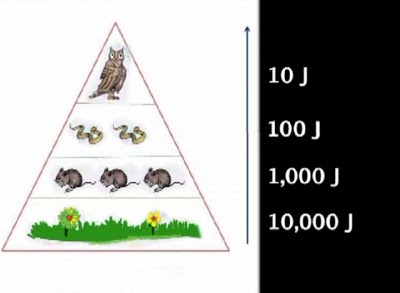Introduction
Trophic levels
Energy transfer and its efficiency
Introduction
Don’t plants also use their own photosynthesised goodies (glucose) to provide energy for their own business (growth, reproduction, etc.) via respiration, and waste stored energy in their tissues upon their death? Of course they do. So less must be available for whatever eats the plant. And whatever eats the plant will also lose energy through excretion for example, so whatever eats this herbivore will have even less energy available to themselves.
Trophic levels
Therefore, at each trophic level in the energy transfer (feeding) hierarchy there is a net loss of energy. This results in a pyramid:

The plants at the bottom are the photosynthesising primary producers. They hold the most energy (Joules) and are fed on by herbivores – primary consumers.
Notice only about 10% of that energy is available one trophic level higher. This is taken by carnivores feeding on herbivores – secondary consumers.
At the very top of the pyramid a mere 0.001% of the original 10,000 J remains (10 J). This is taken by tertiary consumers feeding on…
